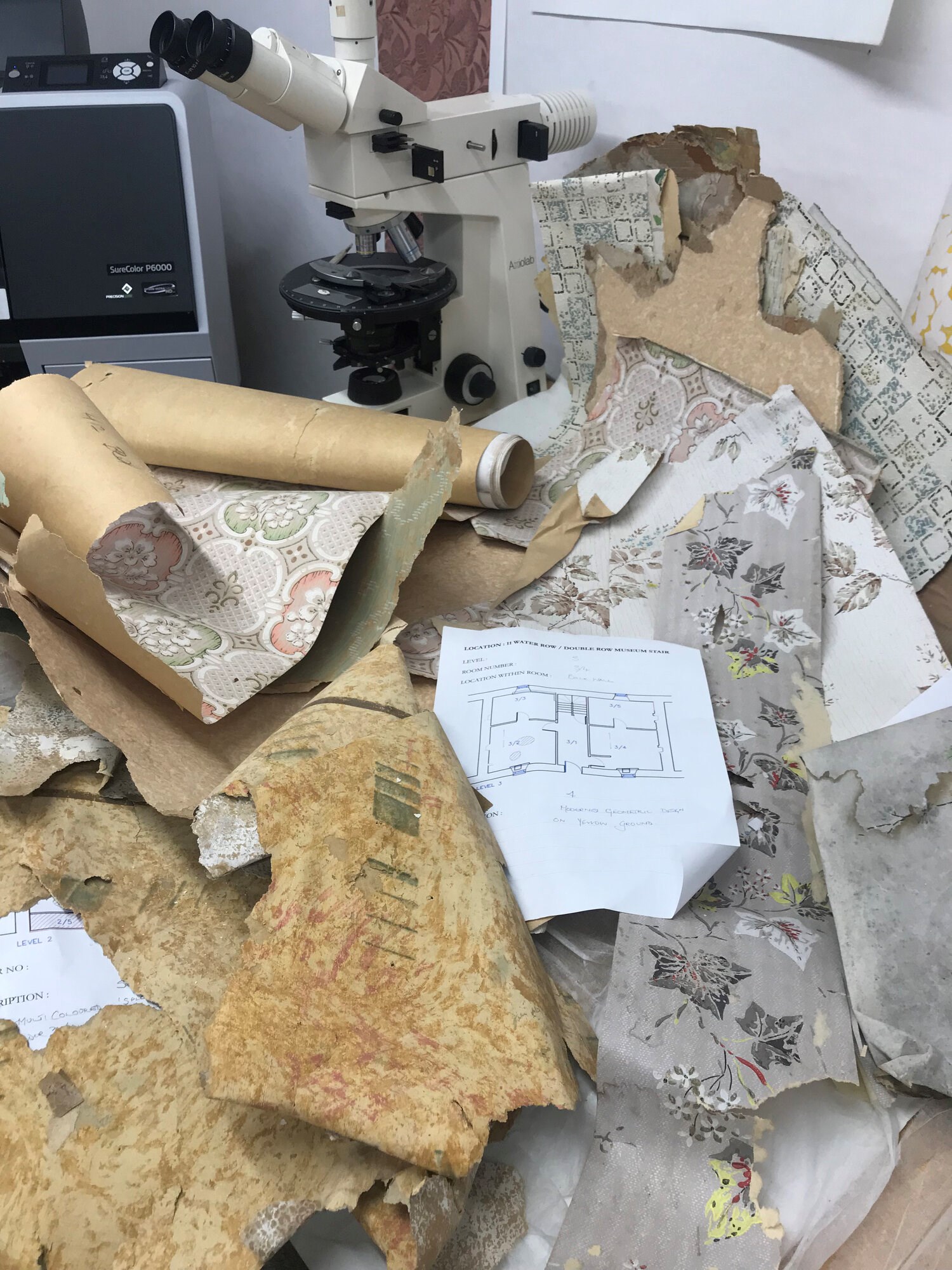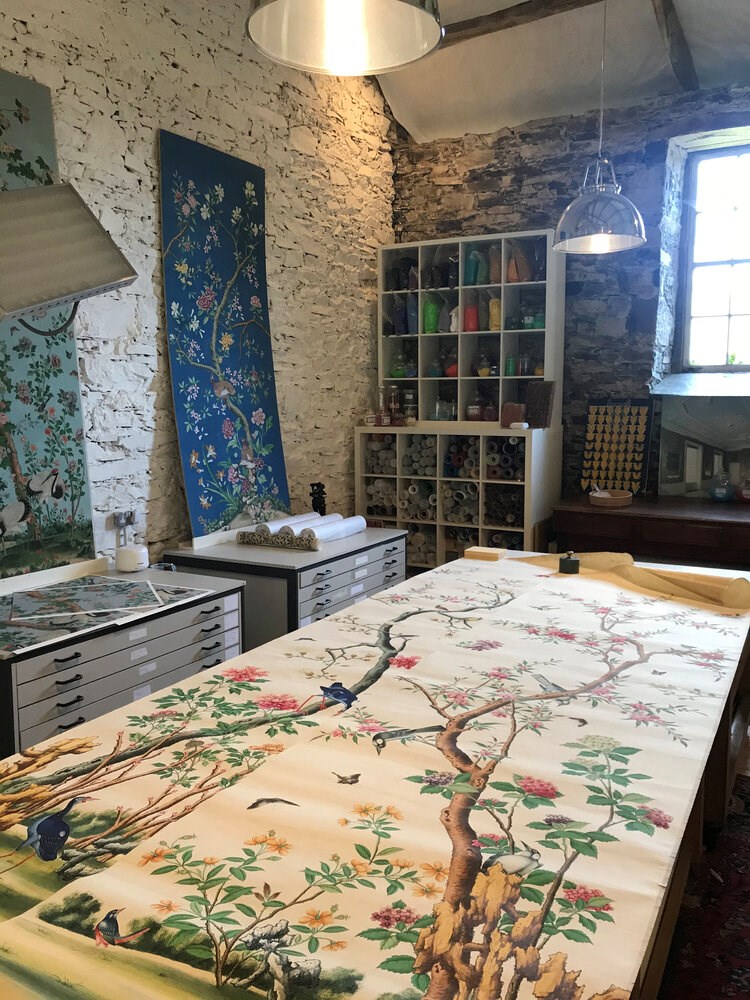Papering the Past
12 August 2021
ShareAntique wallpaper provides an insight into different layers of design history, and, with the skill of specialist restorers, it can live on.
Cal Flyn
Cal Flyn is a writer from the Highlands of Scotland. She writes literary nonfiction and long form journalism. Her first book, Thicker Than Water, was a Times book of the year. Her critically acclaimed second book, Islands of Abandonment—about the ecology and psychology of abandoned places—is out now.

Wallpaper fragments rescued from New Lanark.
Image courtesy of Allyson McDermott.
Have you ever, while decorating, pulled away a fitted cupboard to find another era waiting underneath? An expanse of old wallpaper, perhaps, which has been hidden from view for many decades, or even better—the sheaved edges of every wallpaper that has graced these walls. This is the history of the house, taken corporeal form: layer upon layer of it, sometimes perfectly preserved. And invaluable insight into the tastes and mores of the past.
In Britain, the first wallpapers were monochrome prints of pictorial scenes, or repeating floral patterns. They came in sheets a little smaller than today’s A2 printer paper, and were usually used inside cupboards in 16th century merchants’ houses. By the 17th century, these sheets had morphed into longer rolls of the kind we might recognise, and more complex repeating patterns and block printing techniques were in use. Vivid colours, intricate designs and flock textures soon came to the fore, and took pride of place in the grandest aristocratic houses.
The introduction of machine printing in the 19th century meant that wallpaper became accessible to the masses; since then, we have cycled through many fashions, each iteration of wallpaper telling us something about the era, inspiring revivalist designs, and sometimes retaining significant resale value.
In 2019, for example, Bonhams sold a set of 15 wallpaper panels reputedly removed from Moor Park, a Palladian mansion in Hertfordshire. Dating from between 1790 and 1810, these were prime examples of Chinese wallpaper of the sort that became extremely fashionable in aristocratic circles in the 18th century; at this time, every grand house in Europe would have had at least one ‘Chinese room’ decorated with these intricately hand painted sheets (or European-made ‘chinoiserie’ copies). Authentic Chinese wallpaper was so valuable that it was often removed and rehung in new rooms. The Moor Park Wallpapers featured mountainous landscapes, pagodas, and dragon boats, and were thought to have been removed from the walls when the house was sold and framed. The papers sold for £37,562.
_T638203631729691353.jpeg)
The Moor Park Wallpapers: One of a set of fifteen late 18th century Chinese wallpaper panels, sold for £37,562 inc. premium at Bonhams in November 2019.
Image courtesy of Bonhams.
That same year, Sotheby’s sold a similar suite of wallpaper panels dating from the same period. This suite of 24 panels, featuring watercolour birds flitting through a flowering forest of trees, were first procured for Spetchley Park near Worcester, but never used (“which explains,” the auction listing noted, “the undimmed freshness of the colours”). Initially valued at £50,000 to £100,000, they sold for £137,500.
_T638203631917456522.jpeg)
Retouching Chinese wallpaper from The Royal Pavilion in Brighton.
Image courtesy of Allyson McDermott.
Allyson McDermott, the historic wallpapers expert, had been asked to conduct conservation work on the Spetchley Park wallpapers ahead of the sale. McDermott specialises in complex restoration projects; previously she has undertaken wallpaper conservation at Buckingham Palace, Temple Newsam, and the Royal Pavilion in Brighton, where the Chinese wallpaper of the saloon was removed with palette knives during renovation and rehung in its original position in Queen Victoria’s first floor bedroom.
Antique wallpaper can be extremely difficult to conserve: the paper is often discoloured or bleached unevenly by sunlight. Adhesives can fail, or insects like silverfish might eat away at the surface. The sheets might be as thin as cigarette paper, or imbued with poisonous chemicals. (Scheele’s Green, an arsenic-based dye, was commonly used in 19th century wallpapers; in poor conditions it can produce toxic fumes.) Calling in the experts in such cases is critical.
“I do a lot of testing, and work under the microscope to understand how it’s been made and why it’s in the condition it’s in,” says McDermott. They might be affixed with water-soluble glues, and therefore loosened with moisture; others require solvents, or be removed with a backing layer and separated out later. “Historic wallpapers are very fragile. We very carefully separate it along the joins and lift each sheet off in one piece. It’s real heart-in-mouth stuff.”
Every project is extraordinary, says McDermott: “everything from identifying a tiny fragment and recreating the design, to conserving an entire room of wallpaper. We’re separating layers from a house in London right now. It’s so exciting: you have a sandwich, which you slowly separate out. We’re finding paper dating back to the 1750s. One of the 1770s wallpapers is very, very bright: yellow and black—who would have guessed it?”
McDermott regrets the recent fashion for muted palettes: “Grey, taupe and beige don’t work in Georgian houses. Colour was the thing: blues, greens, reds, yellows—the brighter the colour, the more expensive it was; it was a question of status.” Now her studio also produces a range of contemporary wallpapers based on historic designs, often extrapolated from fragments she has recovered.
“So much craft and skill and talent went into 18th, 19th, early 20th century wallpaper,” she says. “You had to create the design, carve the blocks, know how to flock or gild… an enormous amount of knowledge and craft skill. A really good wallpaper stands alongside a work of art.” Far from ephemeral, the most skillfully designed wallpapers will live on for many centuries.

Chinese wallpaper in Allyson McDermott’s studio.
Image courtesy of Allyson McDermott.

